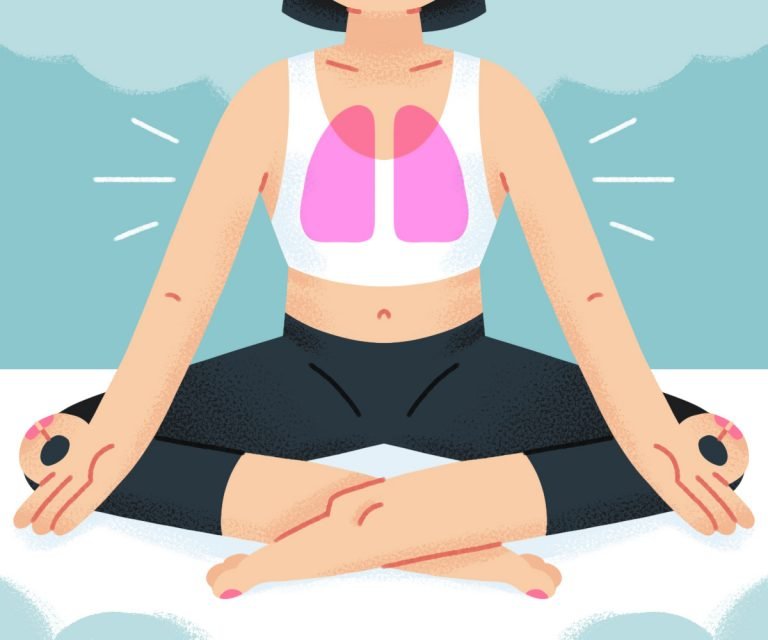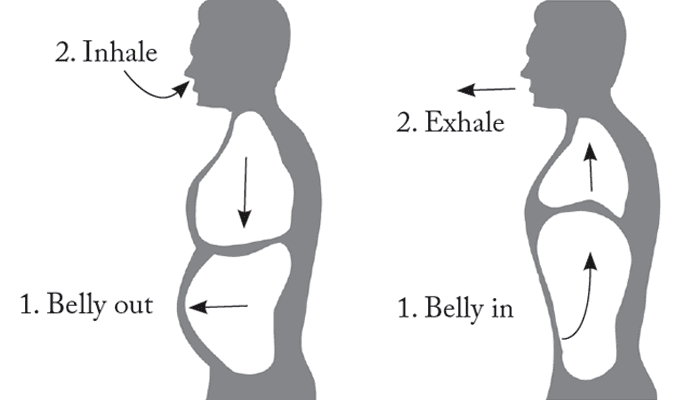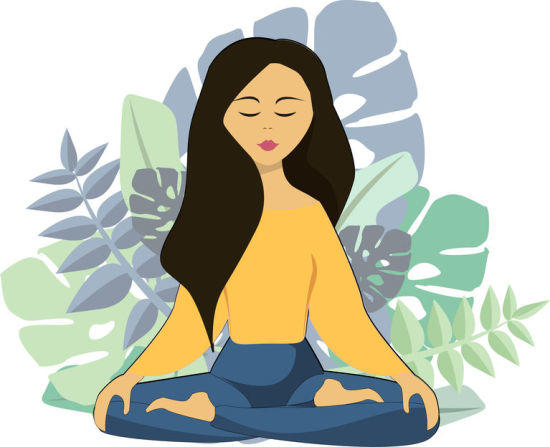When was the last time you noticed your breath? Perhaps when stepping off a treadmill, climbing a hill, or feeling stressed and sensing you weren’t getting enough air? Let me be frank with you: we often don’t give much thought to our breath unless there is a cause behind it. However, your perspective might shift upon learning about the profound benefits of dedicating just 10-15 minutes each day to focusing on your breath.
In this guide, we will understand yoga breathing by exploring:
- What is Breath Work or Pranayama?
- The Benefits of Yoga Breath Exercises
- 7 Yoga Breathwork Exercises for Beginners
- 6 Yoga Poses that Helps you Breath Better
- Breathing Tips For Beginners
- Who is Breathwork not Suitable for?
- FAQs on Yoga Breath Work
What is Yoga Breathing or Pranayama?
Many people have the question, “Is breath work and pranayama the same?” In short, yes. Breath work is also known as pranayama in yoga. It is a beautiful practice of controlling your breath and experiencing the amazing physical and emotional benefits it has to offer.
The word pranayama is made up of two Sanskrit words: prana, which means “life force,” and ayama, which means “expansion” or “control.” Basically, it is the practice of controlling the breath in order to expand and regulate the flow of prana, or life force, through the body.
The Benefits of Yoga Breathing Exercises

Here are some of the benefits of incorporating yoga breath exercises into your routine:
- Stress Reduction: Deep, controlled breathing can activate the body’s relaxation response, leading to a reduction in stress and anxiety levels. This helps in calming the mind and promoting a sense of emotional well-being.
- Improved Lung Function: Pranayama exercises involve conscious manipulation of breath, which can lead to better lung capacity and more efficient oxygen exchange. This can enhance overall respiratory function and increase energy levels.
- Enhanced Focus and Concentration: Certain pranayama techniques, such as alternate nostril breathing, are believed to balance the two hemispheres of the brain and improve cognitive function. This can lead to increased focus, concentration, and mental clarity.
- Better Circulation: Deep and rhythmic breathing improves blood circulation, ensuring that oxygen-rich blood reaches all parts of the body. This can contribute to improved cardiovascular health and overall vitality.
- Detoxification: Deep breathing techniques encourage the elimination of carbon dioxide and other waste products from the body. This helps in detoxifying the system and supporting the body’s natural cleansing processes.
- Relaxation and Sleep: Pranayama exercises can activate the parasympathetic nervous system, which promotes relaxation. Practicing these techniques before bedtime can help improve the quality of sleep and contribute to a sense of rejuvenation.
- Emotional Balance: The breath has a profound impact on the nervous system, influencing emotional states. Breath control can help regulate emotions, manage mood swings, and promote a sense of inner calm.
7 Yoga Breathing Exercises for Beginners

The most common yoga breathing types you must know before stepping into the world of yoga breath work.
1. Deep Abdominal Breathing (Diaphragmatic Breathing)
This foundational breathing technique forms the basis of many other pranayama exercises. Follow these steps:
- Sit or lie down in a comfortable position.
- Place one hand on your chest and the other on your abdomen.
- Inhale deeply through your nose, allowing your abdomen to rise as you fill your lungs with air.
- Exhale slowly and completely, feeling your abdomen sink back down.
- Focus on making your breaths smooth and steady, keeping the chest relatively still while your abdomen moves.
2. Ujjayi Breathing (Ocean Breath)
Ujjayi breathing is often used during yoga practice to synchronize breath with movement. It has a calming effect on the nervous system. Here’s how to do it:
- Sit in a comfortable position or assume a gentle yoga pose.
- Inhale deeply through your nose.
- Exhale through your nose while slightly constricting the back of your throat, creating a soft “haa” sound similar to the ocean waves.
- Maintain this slight constriction in your throat for both inhales and exhales, creating a gentle, rhythmic sound.
3. Alternate Nostril Breathing (Nadi Shodhana)
This balancing breathing technique helps clear energy channels and promotes a sense of harmony within. Follow these steps:
- Sit comfortably with your spine straight.
- Place your left hand on your left knee and use your right thumb to close your right nostril.
- Inhale deeply through your left nostril.
- Use your right ring finger to close your left nostril, releasing your right nostril.
- Exhale slowly and completely through your right nostril.
- Inhale deeply through your right nostril.
- Close your right nostril again and release your left nostril.
- Exhale through your left nostril.
- This completes one cycle. Start with a few cycles and gradually increase the count.
4. Bhramari Breathing (Bee Breath)
Bhramari breathing is excellent for reducing stress and anxiety while calming the mind. Here’s how to do it:
- Find a comfortable seated position.
- Close your eyes and take a few deep breaths to center yourself.
- Using your thumbs, gently close your ears. Place your index fingers lightly above your eyebrows, and the rest of your fingers gently over your eyes.
- Take a deep breath in through your nose.
- As you exhale, make a low, steady humming sound, like a bee. Feel the vibrations in your head.
- Continue this for a few breaths, focusing on the sound and sensation.
5. Equal Breathing (Sama Vritti)
This technique involves equalizing the length of your inhales and exhales. Inhale for a certain count (e.g., 4), and then exhale for the same count. This practice helps calm the mind and balance energy.
6. Lion’s Breath (Simhasana Pranayama)
Sit in a comfortable position. Inhale deeply through your nose, and as you exhale, open your mouth wide, stick out your tongue, and make a “ha” sound while gazing at your third eye. This can release tension in the face and throat.
7. 4 7 8 breathing technique
4-7-8 breathing technique is a simple relaxation exercise designed to calm the mind and reduce stress. Here’s how to do it:
- Inhale quietly through your nose for a count of 4.
- Hold your breath for a count of 7.
- Exhale completely through your mouth for a count of 8, making a whooshing sound.
- This completes one breath cycle. Now inhale again and repeat the cycle for a total of 4 breath cycles.
It’s important to note that while yoga breath exercises offer numerous benefits, they should be practiced with proper guidance, especially if you’re new to pranayama. Here are some of the Some techniques might not be suitable for certain medical conditions, so consulting a qualified yoga instructor or healthcare professional is recommended before incorporating these exercises into your routine.
6 Yoga Poses that Helps you Breath Better
Want to know the best yoga poses that can improve your breathing? Here are they:
1. Sukhasana (Easy Pose): This is a simple cross-legged sitting pose. It helps to create a relaxed and steady posture, allowing you to focus on deep, even breaths. Place your hands on your knees and close your eyes, taking slow and conscious breaths.
2. Pranayama (Breath Control): While not a single pose, pranayama refers to various breath control techniques in yoga. One common technique is “Anulom Vilom” or alternate nostril breathing. This helps balance the flow of energy, clears the nasal passages, and improves lung capacity.
3. Bhujangasana (Cobra Pose): This gentle backbend opens up the chest, expands the lungs, and helps improve breathing. Lie on your stomach, place your palms under your shoulders, and lift your upper body while inhaling deeply.
Also Read: Top 20 Benefits of Surya Namaskar
4. Ustrasana (Camel Pose): This pose involves a deep backbend that opens the chest and encourages deep breathing. Kneel on the floor, tuck your toes, place your hands on your lower back, and gently arch backward while inhaling.
5. Ujjayi Pranayama (Victorious Breath): This is a breath control technique often used in conjunction with yoga asanas. It involves a slight contraction of the throat during both inhalation and exhalation, creating an audible “ocean-like” sound. Ujjayi breathing helps slow down and deepen your breath.
6. Shavasana (Corpse Pose): While this pose is often used for relaxation, it’s also a great opportunity to practice deep breathing. Lie flat on your back, arms at your sides, palms facing up, and close your eyes. Focus on your breath, allowing it to become slow, steady, and natural.
Yoga Breathing Tips For Beginners
Here are a few tips for beginners to get started:
1. Start Slowly: Begin with simple breathing exercises before moving on to more advanced techniques. This will help you get comfortable and build a foundation.
2. Find a Quiet Space: Choose a quiet and calm environment for your practice. This will help you focus and relax more easily.
3. Comfortable Posture: Sit or lie down in a comfortable position. You can sit cross-legged on the floor or on a chair with your feet flat. Make sure your back is straight but not tense.
4. Natural Breath: Pay attention to your natural breathing pattern before you start any exercises. This will help you understand your baseline and notice any changes.
5. Use Your Nose: In most breathing exercises, breathe in and out through your nose. Nasal breathing helps filter and humidify the air before it reaches your lungs.
6. Belly Breathing: Practice diaphragmatic or belly breathing. Let your belly rise as you inhale and fall as you exhale. This helps engage your diaphragm and promotes relaxation.
7. Consistency: It’s better to practice for a short period consistently than to have long sessions irregularly. Aim for a few minutes each day and gradually increase as you become more comfortable.
8. Avoid Straining: Never force your breath or strain your lungs. Breathing exercises should feel comfortable and soothing.
9. Stay Present: Focus on the sensation of breathing. If your mind wanders, gently bring your attention back to your breath.
10. Listen to Your Body: If you feel dizzy, lightheaded, or uncomfortable, stop the practice and return to your normal breathing.
Who is Breath Work Not Suitable For?
Breathwork, like any other practice, might not be suitable for everyone. There are certain contraindications when it coming to yoga breathing exercises. Here are some cases of when when not to do breathing exercises.
1. Respiratory Issues: Individuals with severe respiratory conditions such as chronic obstructive pulmonary disease (COPD), severe asthma, or other lung disorders should consult a medical professional before attempting breathwork exercises. Certain techniques could potentially worsen their condition.
2. Heart Conditions: People with serious heart conditions, such as heart disease or recent heart surgery, should be cautious with breathwork. Some techniques can impact heart rate and blood pressure, so it’s best to consult a doctor first.
3. Pregnancy: Pregnant individuals should be careful with breathwork, especially techniques that involve rapid or forceful breathing. It’s recommended to consult a healthcare provider before trying any new practices during pregnancy.
4. High Blood Pressure: Certain breathwork exercises can influence blood pressure. If you have high blood pressure or a history of hypertension, consult a medical professional before attempting breathwork.
5. Dizziness or Fainting: If you are prone to dizziness or fainting, be cautious with breathwork exercises that involve deep or rapid breathing. Sudden changes in breathing patterns can affect blood oxygen and circulation.
6. Anxiety Disorders: While breathwork can help manage anxiety for many, it might not be suitable for everyone with an anxiety disorder. Some individuals might find certain techniques overwhelming or triggering. It’s best to approach breathwork gently and consult a mental health professional if needed.
7. Seizure Disorders: Certain types of breathwork, particularly those involving rapid or intense breathing, could potentially trigger seizures in individuals with seizure disorders. If you have a history of seizures, consult a doctor before attempting breathwork.
8. Recent Surgery: People who have had recent abdominal or chest surgery should avoid breathwork exercises that involve deep or forceful breathing. Always consult your surgeon or medical provider before trying new practices.
9. Medications: If you’re taking medications that affect heart rate, blood pressure, or breathing, consult your doctor before attempting breathwork. Breathwork can sometimes influence these physiological factors.
10. Personal Comfort: If you feel uncomfortable or anxious during breathwork exercises, it’s important to listen to your body and stop if needed. The goal is to promote relaxation and well-being, not discomfort.
FAQs on Yoga Breath Work
1. What are the 5 Golden Rules for Yoga Breathing?
- Nasal Breathing: Breathe in and out through your nose rather than your mouth. This filters and humidifies the air, making it more suitable for the respiratory system.
- Diaphragmatic Breathing: Focus on deep breathing that engages the diaphragm. This promotes efficient oxygen exchange and relaxation.
- Rhythmic Breathing: Maintain a steady and even rhythm in your breath. Avoid abrupt or jerky breaths.
- Complete Breathing: Use your entire lung capacity, involving the lower, middle, and upper parts of your lungs, to ensure thorough oxygenation and proper CO2 elimination.
- Quiet Breathing: Keep your breaths quiet, soft, and almost imperceptible. This encourages a calm and focused mind.
2. What are the 3 Breathing Techniques of Yoga?
- Ujjayi Breathing: Also known as “Ocean Breath,” this technique involves slight contraction of the throat to create a gentle ocean-like sound during both inhalation and exhalation. It helps maintain focus, heat generation, and relaxation.
- Kapalabhati Breathing: This is a rapid, forceful exhalation followed by a passive inhalation. It’s a cleansing breath that helps clear the respiratory system and energize the body.
- Alternate Nostril Breathing (Nadi Shodhana): In this technique, you use your fingers to alternate between blocking one nostril while breathing in and out through the other. It helps balance the flow of energy in the body and promotes relaxation.
3. What are the 4 Parts of Breath Yoga?
- Inhalation (Puraka): The process of breathing in, which brings fresh oxygen into the body.
- Pause after Inhalation (Antar Kumbhaka): A brief pause holding the breath after inhaling. This allows for oxygen absorption.
- Exhalation (Rechaka): The process of breathing out, expelling carbon dioxide and waste products from the body.
- Pause after Exhalation (Bahya Kumbhaka): A brief pause holding the breath after exhaling. This is a moment of rest and preparation for the next breath cycle.
4. What is the 555 Breathing Technique?
The 555 breathing technique is a relaxation exercise that involves controlling your breath to promote calmness and reduce stress. It’s a simple technique where you inhale for a count of 5, hold your breath for a count of 5, and then exhale for a count of 5. This pattern is repeated for a few cycles. The goal is to regulate your breathing and activate the body’s relaxation response.
5. Do you Breathe Through your Nose or Mouth During Yoga?
In yoga, the general guideline is to breathe through your nose. Nasal breathing is often emphasized because it helps filter and humidify the air, activates the diaphragm more effectively, and encourages a calmer state of mind. However, there are some specific practices in yoga where mouth breathing might be acceptable or necessary, such as certain types of pranayama (breath control exercises) or intense physical postures.
6. How many Breaths do you Have in a Yoga Pose?
The number of breaths you take in a yoga pose can vary widely depending on factors such as the style of yoga, the specific pose, your comfort level, and the instructions of your instructor. In many cases, you might be instructed to hold a pose for a specific number of breaths, which allows you to stay present and mindful in the posture.
7. Do you Hold your Breath in Yoga?
In most yoga practices, the emphasis is on maintaining a steady and controlled breath throughout the practice. Holding the breath is generally discouraged, as it can create tension and disrupt the flow of energy. Instead, the goal is to synchronize your movements with your breath, using inhales and exhales to guide your transitions into and out of poses.
Conclusion
Incorporating these beginner-friendly yoga breathing exercises into your daily routine can have a profound impact on your physical and mental well-being. They are accessible tools that can be practiced anywhere and at any time, helping you find moments of tranquility amidst the hustle and bustle of life. Remember, consistency is key. As you practice these techniques, you’ll gradually notice a sense of inner calm and balance permeating your life, allowing you to reap the full benefits of the ancient art of pranayama.





